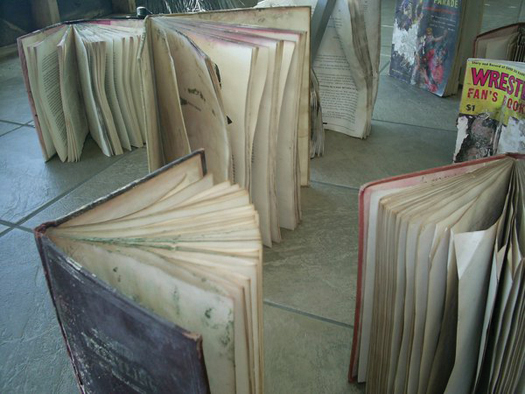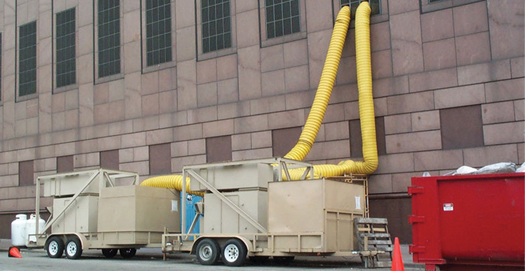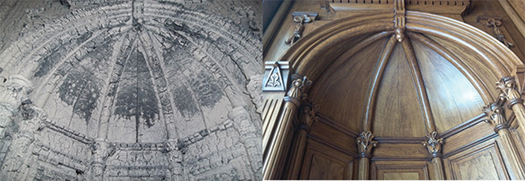Disaster Recovery | Product Spotlight
The fire burned for days. Water—thousands of gallons of it—saturated the library’s materials, equipment, and interior. Smoke and water damage affected 250,000 bound volumes, two million pieces of micrographics, classified and confidential records, historical military documents, and a dedicated server room with more than 100 computer workstations. The Boeing 757 that had ripped through the Pentagon’s three outer rings on September 11, 2001, blasted open the doors to the Pentagon library sandwiched in the middle, the plane’s nose gear hitting the facility’s back wall. By the time staff were permitted to return, devastating moisture had taken over. Materials and equipment, personal belongings, catalog statistics, personnel files, and more were covered with mold and mildew.
BMS CAT, the company hired to restore and recover the library’s collection, set up dehumidification immediately to halt mold growth and materials deterioration. A crew of 25 technicians and supervisors worked daily for a month to recover the collection and facility.
“With the exception of approximately 100 profoundly molded volumes that could easily be replaced, the library was a 100 percent recovery,” says Matt Jaroma, VP of documents for BMS CAT.
When materials are damaged, whether through a leaky roof, a water main break, a fire, or a large-scale disaster, natural or otherwise, the best way to rescue materials is to act intentionally and follow a predetermined plan, Jaroma says.
The most effective method to stabilize water-damaged archival and library materials is by freezing at low temperatures as quickly as possible. The recommended freezing level should be around -30°C (-20°F). Frozen materials should remain in cold storage until freeze-drying can occur. If the water source is overhead, protect documents with plastic sheets or tarps until the water can be turned off. If from below, move documents in water’s path to an elevated location. When safe, remove standing water with a wet vac. Take steps to reduce humidity and increase air circulation. Use in-house air conditioners to bring temperatures down and remove moisture from the air. Employ fans, air movers, or air scrubbers to create air flow.
When working with items or records containing mold, trained workers should wear masks or respirators and disposable gloves. It is not recommended to allow library employees to perform mold mitigation or remediation services.
Product: National Heritage Responders Company: American Institute for Conservation of Historic and Artistic Works

National Heritage Responders (NHR) operates under the Foundation of the American Institute for Conservation of Historic and Artistic Works (FAIC), providing assistance after disasters and emergencies by responding to the needs of cultural institutions through coordinated efforts with first responders, state agencies, vendors, and the public. The group provides assistance by phone and email to collecting institutions. NHR has deployed experts to assist with major floods and hurricanes. After each event, information is shared and techniques are evaluated and refined by team members.
Jessica Unger, the emergency programs coordinator for FAIC, says NHR receives calls from those seeking guidance on how to handle wet and/or moldy materials and what health and safety considerations staff responders should consider. Unger says NHR’s volunteer team has a diversity of backgrounds; they are librarians, archivists, conservators with a variety of specialties, and other collections care professionals. Their largest project to date has been a joint effort with the Smithsonian Institution and the U.S. Committee of the Blue Shield (USCBS) to recover cultural and historic artifacts damaged in Haiti’s 2010 earthquakes. FAIC sent 21 conservators for a total of 233 days with the support of the National Endowment for the Humanities, National Endowment for the Arts, Institute of Museum and Library Services, and donations from individuals. The group set up conservation labs at the Haiti Cultural Recovery Center to restore paintings and works on paper. Volunteers labored over iconic pieces, cleaned dust and mold from thousands of items, and helped train Haitian specialists to continue the important work.
For more information, visit www.conservation-us.org/nhr. NHR’s hotline is available 24-7 at 202-661-8069.
Product: BMS CAT Company: Blackmon Mooring & BMS CAT

BMS CAT has significant experience in document and special media recovery following a disaster. It also offers extensive services to restore a facility after a disaster, with on-staff experts in fire and smoke damage restoration, water damage restoration, HVAC decontamination, dehumidification, mold remediation, construction services, storm damage repair, multifamily facilities, and disaster planning.
VP of documents Matt Jaroma says BMS CAT also provides a chain-of-custody when handling sensitive materials to ensure the materials’ location can be followed at all times. Items are barcoded when allowed and tracked in BMS CAT’s system.
BMS CAT uses mechanical compression during freeze-drying, the method preferred over desiccant drying by the National Archives.
“Other companies use bungee cords for freeze-drying books, which leads them to distort and cockle,” Jaroma says, adding that BMS CAT also offers the largest freeze-dry capacity of any company in the country, with the ability to process nearly 10,000 cubic feet of documents at one time in their Haltom City, TX, facility, processing large numbers of materials in times of crisis when a significant area might be affected by disaster.
BMS CAT’s size and national footprint, with locations throughout the United States, give the company the ability to mobilize people and equipment quickly to affected areas.
For more information, visit www.bmscat.com or contact mjaroma@bmscat.com.
Product: BELFOR Restoration Company: BELFOR USA

BELFOR can restore almost any type of document, including books, files, magazines, and manuscripts. It also focuses on archives, special collections, audio- and videotapes, blueprints, maps, and vital records. Its restoration process reaches to photographs, film, negatives, slides, X-rays, and microfiche/microfilm as well. Security measures at BELFOR include secured access and video monitoring, fenced-in buildings, and passcode entry to handle high-security and government documents.
BELFOR’s document restoration specialists use desiccant drying, vacuum freeze-dryers, thermal vacuum freeze-dryers, and molecular sieves specifically designed to restore books, documents, and paper materials exposed to water. BELFOR’s National Technical Services Division’s paper recovery professionals inventoried, packed, transported, treated, repackaged, and restored one of the world’s largest herbaria collections from Harvard University.
BELFOR’s paper recovery process for fire and smoke damage includes particulate removal sponges, ionized air washing, and deodorization techniques, while materials affected by mold, mildew, or bacteria are sterilized via gamma radiation or electron beam radiation, preventing further contamination or decay. BELFOR is also one of the few restoration companies able to perform asbestos and lead removal on documents.
BELFOR has a large inventory of mobile freeze-dry chambers worldwide to freeze most documents on-site. The majority of document projects are frozen, inventoried, then packed and shipped to a BELFOR Document Lab for further recovery in one of its fixed freeze-dry chambers in North America, British Columbia, and Ontario.
For further information, visit www.belfor.com or call the 24-7 emergency number at 1-800-856-3333.
Product: Document Recovery Solutions Company: Polygon

Polygon’s vacuum freeze-drying chambers restore water-damaged materials quickly and effectively by placing them in an airtight chamber with negative vacuum pressure, keeping frozen documents from becoming reliquefied, thereby preventing warping and distortion.
With a desiccant dehumidification process, the room atmosphere is maintained at about 68ºF and 12 percent humidity, removing moisture from documents within one to seven days, depending on the severity of damage.
Polygon also offers cleaning services to remove dirt and fungi spores from each document with sponges and scrub pads, avoiding liquid solutions that would reactivate the moisture in the materials. High Efficiency Particulate Air (HEPA) vacuum systems are used to prevent the circulation of mold spores, and materials exposed to hazardous waste or black water are sterilized with gamma irradiation. The company also provides digital imaging after or instead of restoration.
Polygon’s 24-7 Emergency Response includes a large fleet of drying and climate-control equipment, several dedicated recovery centers, and more than two dozen offices across North America as well as a global network in 13 countries.
For more information, visit www.polygongroup.com, call 1-800-422-6379, or email us_info@polygongroup.com.
RELATED
ALREADY A SUBSCRIBER? LOG IN
We are currently offering this content for free. Sign up now to activate your personal profile, where you can save articles for future viewing









Add Comment :-
Comment Policy:
Comment should not be empty !!!